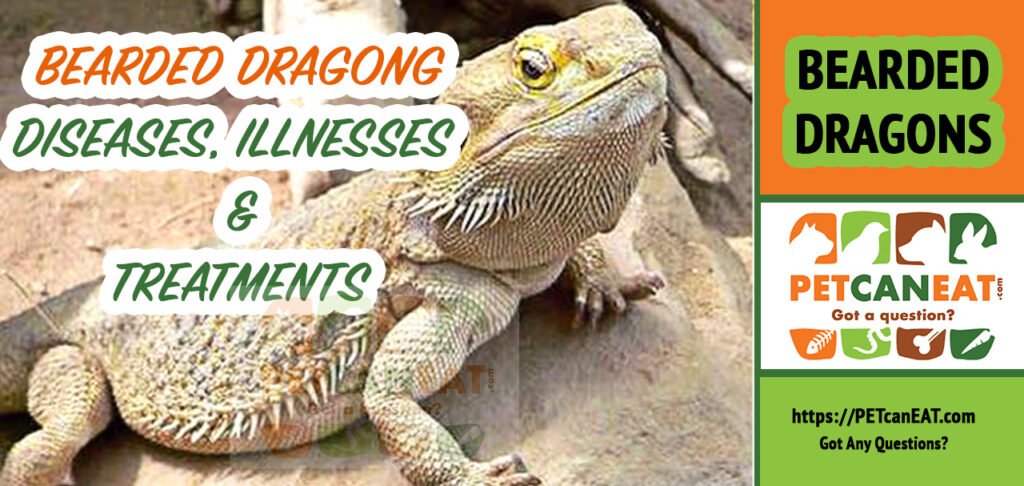So now you got your first bearded dragon pet, congratulations! It’s time to know about some of the most common bearded dragon illnesses and diseases, symptoms, and treatments. This way, you’ll know what to expect and won’t be caught by surprise.

Bleeding wounds
Bleeding wounds or injuries can be taken care of by using pressure to stop bleeding. The wounds can be cleaned with water and an antiseptic to prevent any bacterial or toxin infections. Make sure to keep the wound site clean.
You can also use a triple antibiotic ointment to help aid the healing process. If wounds don’t show signs of healing, don’t stop bleeding, or are infected, it is time to get your dragon to a veterinarian for diagnoses and treatment.
Bearded Dragon Abscesses
Abscesses are small wounds that go untreated and become infected. These are serious because they harbor bacteria and toxins. If these go untreated, they will rupture and lead to septicemia.
These kinds of injuries need immediate veterinarian help.
Bearded Dragon Burns
Burns will occur if your dragon gets too close to its basking lamp or you have a malfunction with one of your heating devices.
How to avoid bearded dragon burns
- Make sure that your dragon cannot touch their basking lamp. If able to, they will press their bodies against the light and not know they are being burned.
- Check your heating equipment now and then to make sure that it is properly working.
Burns, depending on severity, will require a veterinarian visit.
Dehydration and shock go along with burns, as well.
Bearded dragon metabolic bone disease
Metabolic bone disease in Bearded Dragons is where your Bearded Dragon lacks calcium and vitamin D3.
This deficiency can cause the following:
- softening, and deformity of bones
- fractures of limbs.
- In severe cases, Bearded Dragon will experience complete immobility.
If caught early enough, MBD can be reversed, in many cases, quite easily. Treatment is done by giving supplements, calcium powder-coated live food, or giving Vitamin D.
Vitamin D is naturally present in very few foods, added to others, and available as a dietary supplement. It is also produced endogenously when ultraviolet rays from sunlight or UVB lamps strike the skin and trigger vitamin D synthesis.
- Vitamin D is essential for promoting calcium absorption in the gut.
- It’s also necessary for maintaining adequate serum calcium and phosphate concentrations to normal bone mineralization.
- Lastly, it’s vital in preventing hypocalcemic tetany. Without vitamin D3, your Bearded Dragon bones become thin, brittle, or misshapen.
To prevent Bearded Dragon metabolic bones disease, you will need to apply proper diet and care; your dragon shouldn’t develop this problem. Though, even with the best care, things can still go wrong. If you do happen to come by this illness, it is reversible.
Bearded Dragon Mites
Bearded Dragons mites are not susceptible but can happen. These mites are relatives to ticks and are 1mm in size. Most look like black dots moving on your Bearded Dragon. You most likely spot mites when they have drowned in your Bearded Dragon water bowl.
How to get rid of bearded dragon mites
You can use an invermectin spray is the most widely prescribed product. It can be done by diluting 5-10 mg of ivermectin with a quart of water and apply directly to your dragon.
You can use a cotton swab to apply around the mouth, eyes, and nostrils. Ivermectin is usually only available by prescription from a vet.
Some will inject it right into your reptile, but it’s recommended not to be injected or advised.
You will also need to clean the enclosure to eliminate your Bearded Dragon’s mites completely.
How to clean your bearded dragon’s vivarium against mites
You can use the same invermectin spray for this as well.
You will want to soak all cage furnishings for about a half-hour and discard the substrate.
You can also use a 10% bleach and water solution for cleaning the cage and cage fixtures.
To learn more about Bearded Dragon Mites, you can read Melissa Kaplan’s article. Here is the link to the article: http://www.anapsid.org/mites.html
Bearded Dragon Impaction
Bearded Dragon owners’ worst nightmare is impaction which can cause lots of dame to the digestion tract.
In extreme cases, your Bearded Dragon will often die if not having an emergency operation to remove the non-digestible material. This is like human constipation but doesn’t go.
Many Bearded Dragon keepers have these problems accrue when their Bearded Dragon starts to eat the substrate.
The substrate then causes a blocked digestion tract. It can also accrue when food fed is too large.
Also, live food that has a hard chitinous shell can cause impaction. Others also acquire that it can be caused by basking temperatures which makes it harder for your Bearded Dragon to digest the food it’s been given.
Some Bearded Dragon owners only have their bearded dragons on slate tiles that are too large to consume and grind down their nails. When using a substrate, please do remove it if your Bearded Dragon continues to eat the substrate. I use chipsi mais corncob.
Chipsi Mais Corncob
Chipsi Mais granules are made from corn cob, a natural product that is much heavier than regular softwood shavings. This means that the corn granules do not stick to your pet’s fur or feathers and are not spread outside the hutch or cage. These natural granules are highly absorbent for liquids and odors, creating a pleasant environment for you and your pet.
Bearded Dragon Coccidia
Bearded Dragon Coccidia is a digestion tract parasite that captivity Bearded Dragons carry. Your Bearded Dragon most likely has small amounts of this parasite, but your Bearded Dragon immune system can keep it under control. But in large numbers, it will significantly affect your Bearded Dragon.
Your Bearded Dragon will usually pass out this parasite, but this small number of parasites soon multiply into large numbers when it gets swallowed again. These parasites most get re-swallowed from their water and food dishes.
The signs of your Bearded Dragon having coccidia are your bearded dragon being stressed. When your Bearded Dragon becomes stressed, it lowers the immune system causing an outbreak in coccidia. You must remember this when you move your Bearded Dragons from one place to another place. Like when moving house or bringing your new bearded dragons from the previous owner to your vivarium. Please do remember this when collecting your baby bearded dragons.
If your Bearded Dragon does get a coccidia outbreak, you must take your dragon to a vet. Your veterinarian will prescribe a sulpha drug, such as Albon. They will let you know how much to give and how to administer it. At this time, it is also essential to keep your dragon’s cage as clean as possible. You will need to be anal about cleaning it. At this time, it would be better to use newspaper as substrate and change it out once or twice a day.
Bearded Dragon Tail Rot
Bearded Dragon tail rot is a health problem from time to time, but if caught early, it can be treated, but the more time it’s left untreated, the more painful also severe it becomes. The symptoms are lethargy, refusing to eat, and darkening of tail other times. But darkening of tail sometimes means your bearded dragon is close to shedding.
The causes of tail rot are nipped tails or tail trauma, usually caused by a falling object that crushes your bearded dragon’s tail. The second cause of bearded dragon tail rot is shedding skin not being removed from the tail. This unshedded skin then builds up over time and tightens, stopping the blood flow from that point onwards. This can also happen on the other limbs.
Tail rot can be prevented by ensuring that any of the objects within their vivarium cannot fall or pinch your bearded dragon’s tail. When your bearded dragon is shedding, you can give them a bath in pain lukewarm water, which helps your bearded dragon shed skin lifts. You can have Hydrogen peroxide, which helps soften the skin; also, Hydrogen peroxide can treat the infection.
Sometimes when your bearded dragon skin isn’t shedding well, you can gently pell it away by hand. I mostly do this to the legs, feet, toes, tail, and facial area.






